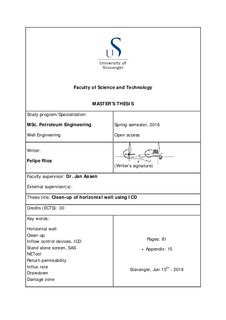| dc.contributor.author | Rios Fuentes, Edwin Felipe | |
| dc.date.accessioned | 2016-09-21T12:23:11Z | |
| dc.date.available | 2016-09-21T12:23:11Z | |
| dc.date.issued | 2016-06-13 | |
| dc.identifier.uri | http://hdl.handle.net/11250/2409318 | |
| dc.description | Master's thesis in Petroleum engineering | nb_NO |
| dc.description.abstract | An efficient clean-up process is a key factor determining horizontal wells productivity. Numerous factors cause formation damage around wellbore vicinity and numerous treatments have been developed to mitigate each damaging factor. In this project the main damage contributing elements are associated to polymer and particle trapping during drilling stage. Likewise, we set the return permeability as the key factor to define the clean-up process efficiency in horizontal wells completed with ICD-inflow control devices.
Knowing the drilling fluid properties, lab experimental simulations of return permeability are upscale to field conditions under a geometrical damage region established as a truncated cone. Reported dynamic filtration data from a very long horizontal well located in the Norwegian Continental Shelf, is used to define the geometrical damage region; and it is subsequently subdivided into small segments along the horizontal section for improved interpretation. Cumulative flow passing through each segment determines the return permeability and therefore, the clean-up efficiency.
Influx simulations of the horizontal well segments are coupled with the lab experimental simulations to evaluate the evolution in time of the return permeability and its effect at the heel and toe section of the well. In order to impose the drawback of static simulations, we incorporate a transient flow regime analysis into the horizontal well productivity equation.
An iterative process of modelling lead us to find that return permeability recovery is very high at the beginning of the clean-up process while maintaining a slightly increase at late times. The benefit of using ICD-Inflow Control Devices for clean-up process compared to SAS-Stand Alone Screens is demonstrated by the evolution in time of the return permeability at the toe, solving one of the most common concerns in horizontal wells productivity.
This model can be used to determine the time it takes to obtain a certain value of return permeability at the heel and toe of the horizontal section. Likewise, flow rate sensitivity analysis can be performed to obtain the optimum clean-up flow rate for the process. Its great advantage for the well planning stage lies on the fact that no lab experiments needs to be performed and it can be used when no data from production logging is available. | nb_NO |
| dc.language.iso | eng | nb_NO |
| dc.publisher | University of Stavanger, Norway | nb_NO |
| dc.relation.ispartofseries | Masteroppgave/UIS-TN-IPT/2016; | |
| dc.subject | petroleumsteknologi | nb_NO |
| dc.subject | petroleum engineering | nb_NO |
| dc.subject | ICD | nb_NO |
| dc.subject | NETool | nb_NO |
| dc.subject | Influx rate | nb_NO |
| dc.subject | petroleumsteknologi | nb_NO |
| dc.subject | boreteknologi | nb_NO |
| dc.subject | horizontal well | nb_NO |
| dc.subject | clean-up | nb_NO |
| dc.subject | inflow control devices | nb_NO |
| dc.subject | stand alone screen | nb_NO |
| dc.subject | return permeability | nb_NO |
| dc.subject | drawdown | nb_NO |
| dc.subject | damage zone | nb_NO |
| dc.title | Clean-up of horizontal well using ICD | nb_NO |
| dc.type | Master thesis | nb_NO |
| dc.subject.nsi | VDP::Technology: 500::Rock and petroleum disciplines: 510::Petroleum engineering: 512 | nb_NO |
